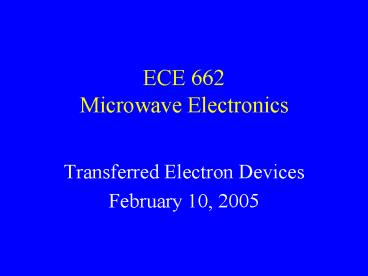ECE 662 Microwave Electronics - PowerPoint PPT Presentation
1 / 31
Title:
ECE 662 Microwave Electronics
Description:
ECE 662 Microwave Electronics Transferred Electron Devices February 10, 2005 Two-Terminal Negative Resistance Devices Transferred Electron Device Operation (TED ... – PowerPoint PPT presentation
Number of Views:502
Avg rating:3.0/5.0
Title: ECE 662 Microwave Electronics
1
ECE 662Microwave Electronics
- Transferred Electron Devices
- February 10, 2005
2
Two-Terminal Negative Resistance Devices
3
Transferred Electron Device Operation (TED)
4
Review of Carrier Transport
5
Review of Carrier Transport
6
Drift Velocity vs. Electric FieldSilicon at Room
Temperature
Ref. Sze
7
Drift Velocity vs Electric Field
Ref Sze
8
High Field Transport in n-type GaAs
9
Negative Differential Resistance in n-type GaAs
10
Measured velocity-field characteristics
Ref Sze
11
Review of Carrier Transport
12
Transferred Electron Device Operation (TED)
13
Transferred Electron Device Operation (TED)
14
Electron accumulation in the Presence of
Negative Differential Resistivity (NDR) Ref Liao
15
Gunn Diode
16
Eventually, the process evens out and velocities
are equal. Space charge than drifts to anode end
and the process repeats.
17
Dipole Layer in Negative Differential Resistivity
(NDR) Ref Liao
18
- To (d)
- Electric field vs.
- distance during
- one ac cycle at
- Four intervals, a
- to d.
- e) Voltage and
- Current wave
- Forms of a
- Transit time
- Domain mode.
- Ref. Sze
19
Gunn Domain Modes
Ref Liao
20
Numerical simulation of the time- dependant
behavior of cathode- nucleated TED for the
transit-time domain mode. Each successive time
is 24ps. ref. Sze
21
Gunn Domain Modes
Ref Liao
22
Numerical simulation of the time- dependant
behavior of cathode- nucleated TED for the
quenched domain mode. Each successive time is
24ps. ref. Sze
23
(No Transcript)
24
(No Transcript)
25
Bias- dependent RF characteristics of a
D-band InP TED
26
Mechanical tuning characteristic for the
D-band InP TED close to maximum bias
27
Typical Structures and Doping Profiles for TED
Devices
Ref. Sze
28
Solid-State Device Power Output vs Frequencyref
Sze and modifiedby Tian
29
State-of-theArt RF Power Levels for TED under CW
operationref. Sze
30
Summary of Transferred Electron Devices - 1 Ref
Golio (2003)
- Widely used in oscillators from the microwave
through high mm-wave frequency bands. - Good RF output power capability (mW to W level)
- Moderate efficiency (20)
- Excellent noise and bandwidth capability
31
Summary of Transferred Electron Devices - 2 Ref
Golio (2003)
- Fabricated at low cost
- Excellent price-to-performance ratio, for
example, most common oscillator device used in
police automotive radars - Many commercially available solid-state sources
for 60 to 100 GHz (for example, automotive
collision-avoidance radars) often use InP TEDs.































